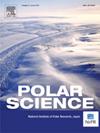格陵兰西北部图勒地区环斑海豹季节性栖息地利用情况
IF 2
4区 地球科学
Q3 ECOLOGY
引用次数: 0
摘要
最近格陵兰海岸的快速环境变化对北极海洋哺乳动物产生了重大影响。潮汐冰川的融化影响海洋环境和生态系统,可能改变北极海洋哺乳动物的分布和行为。环斑海豹(Pusa hispida)是北极海洋生态系统的关键物种。在这项研究中,在格陵兰西北部图勒地区的潮汐冰川附近,为4只环海豹配备了Argos电导率-温度-深度(CTD)卫星中继数据记录器,以研究它们的行为与海洋环境之间的关系。在开放水域期间,所有的海豹大部分时间都呆在潮汐冰川前沿附近。在此之后,由于陆固冰的形成,这两只海豹离开了冰川峡湾,留在了北水峡地区,在冰覆盖时期,那里的海冰相对较薄且稀疏。此外,CTD数据表明环斑海豹主要潜入极地鳕鱼(Boreogadus saida)居住的水域深处。这些栖息地利用特征与冰和猎物物种的分布有关,可能会影响该物种在未来气候变化下的分布和生态。本文章由计算机程序翻译,如有差异,请以英文原文为准。
Seasonal habitat use of ringed seals in the Thule area, northwestern Greenland
Recent rapid environmental changes along the Greenland coast have significantly impacted Arctic marine mammals. The melting of tidewater glaciers influences ocean environments and ecosystems, potentially changing the distribution and behavior of Arctic marine mammals. The ringed seal (Pusa hispida) is a keystone species in the Arctic marine ecosystem. In this study, four ringed seals were equipped with Argos conductivity-temperature-depth (CTD) satellite relay data loggers close to tidewater glaciers in the Thule area of northwestern Greenland to investigate the relationship between their behavior and the marine environment. All seals spent most of their time in the vicinity of tidewater glacier fronts during the open-water period. After that period, the two seals moved out of the glacial fjords due to the formation of land-fast ice and stayed in the North Water Polynya area, where sea ice was relatively thin and sparse during the ice-covered period. Furthermore, CTD data suggest that ringed seals mainly dove to the depths of the water inhabited by the polar cod (Boreogadus saida). These habitat use characteristics, associated with distribution of ice and prey species, could potentially affect the distribution and ecology of this species under future climate change.
求助全文
通过发布文献求助,成功后即可免费获取论文全文。
去求助
来源期刊

Polar Science
ECOLOGY-GEOSCIENCES, MULTIDISCIPLINARY
CiteScore
3.90
自引率
5.60%
发文量
46
期刊介绍:
Polar Science is an international, peer-reviewed quarterly journal. It is dedicated to publishing original research articles for sciences relating to the polar regions of the Earth and other planets. Polar Science aims to cover 15 disciplines which are listed below; they cover most aspects of physical sciences, geosciences and life sciences, together with engineering and social sciences. Articles should attract the interest of broad polar science communities, and not be limited to the interests of those who work under specific research subjects. Polar Science also has an Open Archive whereby published articles are made freely available from ScienceDirect after an embargo period of 24 months from the date of publication.
- Space and upper atmosphere physics
- Atmospheric science/climatology
- Glaciology
- Oceanography/sea ice studies
- Geology/petrology
- Solid earth geophysics/seismology
- Marine Earth science
- Geomorphology/Cenozoic-Quaternary geology
- Meteoritics
- Terrestrial biology
- Marine biology
- Animal ecology
- Environment
- Polar Engineering
- Humanities and social sciences.
 求助内容:
求助内容: 应助结果提醒方式:
应助结果提醒方式:


